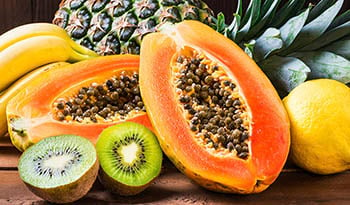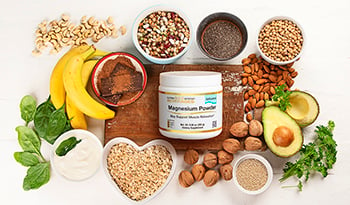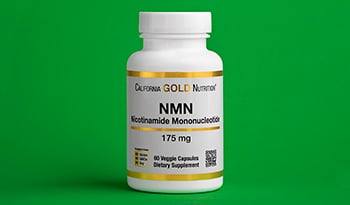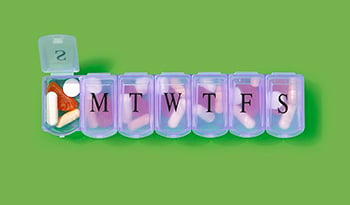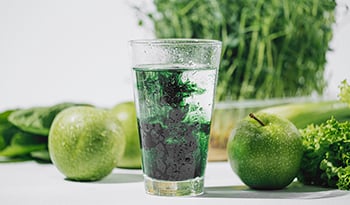8 Types of Vitamin B and Their Health Benefits

There are eight B-vitamins, and they all play important roles in overall health and in energy metabolism. They are specifically important in the metabolism of fats, carbohydrates, sugar, and proteins and help the body transform these important nutrients into energy.
All B-vitamins are water-soluble, which means that any unused or excess amount present in the blood is excreted in the urine. Most B-vitamins are never stored in the body. The exceptions are vitamin B12 and vitamin B9 (also known as folate). This is different from fat-soluble vitamins, A, D, K and E, which are stored in the body.
Vitamin B1 (Thiamine)
Vitamin B1 or thiamine is frequently forgotten and does not get the attention other B vitamins get. However, it’s very important, and if you’re deficient in vitamin B1, you can develop deficiency conditions known as beriberi, wet beriberi with congestive heart failure or Wernicke encephalopathy, a condition that affects the mind and memory.
However, more frequently, one may have a reduced appetite, fatigue, and sometimes delirium.
Risk factors for vitamin B1 deficiency
- Heavy alcohol use
- Digestive or malabsorption disorders
- Unhealthy diet
- Weight-loss surgery (malabsorption is common)
- Dialysis
- Taking diuretics and acid-reducing medications
Symptoms of vitamin B1 deficiency
- Lack of appetite
- Decreased muscle function
- Congestive heart failure
- Tingling in hands and feet (peripheral neuropathy)
- Mental confusion or speech difficulty
- Nausea and vomiting
Food sources of vitamin B1
- Yeast
- Whole grains
- Chia seeds/almonds
- Legumes (beans, lentils)
- Eggs
- Meat (beef, pork)
Most who take vitamin B1 supplements consume between 50 to 500 mg. These can be taken as part of a multivitamin, a B-complex, or individual supplement. B vitamins are also available in gummy formulations.
Vitamin B2 (Riboflavin)
Riboflavin is an important vitamin that plays a role in energy metabolism. It is crucial for mitochondrial health and wellness, where it is part of two important coenzymes. Riboflavin helps break down fats, proteins, and carbohydrates, so they can be used for cellular energy. When consumed, vitamin B2 is absorbed in the small intestine. Bacteria in the large intestine are also able to manufacture riboflavin.
Risk factors for vitamin B2 deficiency
- Chronic alcohol use
- Consuming a vegetarian diet
- Pregnancy or lactation
- Digestive or malabsorption disorders
- Poor diet
- Weight-loss surgery
- Dialysis
- Taking diuretics and acid-reducer medications
Symptoms of vitamin B2 deficiency
- Fatigue
- Rash in the corner of the mouth
- Hair loss
- Anemia
- Cataracts
- Nervous system abnormalities
- Migraine headaches
Food sources of vitamin B2
- Egg yolks
- Organ meats (kidney, liver)
- Meats (beef, chicken and pork)
- Seafood (tuna, salmon)
- Green vegetables
- Chia seeds/almonds
- Soybeans
- Cereals (fortified)
Riboflavin has been shown to be effective in preventing migraines. A 2017 study in the Journal of Clinical Pharmacy and Therapeutics, which evaluated 11 studies, concluded: “Riboflavin is well-tolerated, inexpensive, and has demonstrated efficacy in the reduction of adult patient's migraine headache frequency”.
A 2014 study in Canadian Family Physician also demonstrated riboflavin’s usefulness in children with migraine headaches.
Ideally, vitamin B2 should be consumed via diet, but if needed, it can be taken as part of a multivitamin, a B-complex, or individual supplement. Suggested dose: Adults – riboflavin 100 to 400 mg daily. Children – 100 to 400 mg daily.
Vitamin B3 (Niacin)
Vitamin B3 can be found in two different forms: the first is niacin (also known as nicotinic acid), and the second is niacinamide (also known as nicotinamide). In either form, vitamin B3 is a precursor to nicotinamide adenine dinucleotide (NAD), which plays a vital role in helping mitochondria — the cell’s powerhouse — create energy.
Risk factors for vitamin B3 deficiency
- Chronic alcohol use
- Digestive or malabsorption disorders
- Poor diet
- Weight-loss surgery
- Dialysis
Symptoms of vitamin B3 deficiency
- Memory loss
- Headaches
- Fatigue
- Depression
- Apathy
- Delirium
- Vomiting
Food sources of vitamin B3
- Yellowfin tuna
- Poultry (chicken, turkey)
- Meat (pork, beef)
- Portabella mushrooms
- Brown rice
- Peanuts, nuts, seeds (chia seeds)
- Avocados, green peas, sweet potatoes
Vitamin B5 (Pantothenic Acid)
Vitamin B5 is an essential vitamin. Humans and animals require vitamin B5 to help manufacture coenzyme A (CoA), an important enzyme required to metabolize fat, carbohydrates, and proteins. In other words, vitamin B5 helps convert food into energy. It also helps the liver break down certain prescription drugs and toxins. Animal studies have shown that mice who are deficient in pantothenic acid are prone to premature graying. However, there is no evidence that pantothenic acid reverses gray hair in humans.
Risk factors for vitamin B5 deficiency
- Heavy alcohol use
- Digestive or malabsorption disorders
- Poor diet
- Weight-loss surgery
Symptoms of vitamin B5 deficiency
- Irritability
- Fatigue
- Hypoglycemia
- Nausea and vomiting
- Abdominal cramping
Food sources of vitamin B5
- Shiitake mushrooms
- Meats (liver, beef, fish)
- Dairy (milk, yogurt and cheese)
- Egg yolks
- Sunflower seeds
- Peanuts
Vitamin B6 (Pyridoxine)
Vitamin B6 is involved in over 100 biochemical reactions in the human body and plays an important role in nerve and overall brain health. It is also important in the metabolism of sugar molecules, cholesterol, and protein. A 2008 study showed that “substantial proportions of some population subgroups” do not have sufficient vitamin B6 levels. A deficiency is also frequently present in those who are low in vitamin B12 and folic acid.
Risk factors for vitamin B6 deficiency:
- Regular or excessive alcohol consumption
- Obese or overweight
- Pregnancy
- Malabsorption conditions (leaky gut, celiac disease, Crohn’s disease, ulcerative colitis)
- Being elderly
- Consuming a vegetarian diet
- Medications
Medications such as the diabetes drug metformin, and the diuretic furosemide, can increase the risk of vitamin B6 deficiency. Women who take birth control pills, or who are former users of birth control pills, are also at risk for vitamin B6 deficiency according to studies, so extra caution should be taken.
Vitamin B6 is absorbed in the jejunum, the mid-portion of the small intestine. Having good gut health is important for absorption of all vitamins and minerals.
Symptoms of vitamin B6 deficiency
- Seborrhea dermatitis (dry scalp)
- Fatigue
- Confusion
- Numbness/carpal tunnel syndrome
Food sources of vitamin B6:
- Meat (pork, beef, and beef liver)
- Poultry (turkey/chicken)
- Seafood (salmon/tuna)
- Chickpeas
- Bananas
- Potatoes
- Pistachios, nuts, seeds (chia seeds, in particular)
It is recommended that most adults consume 1 to 2 mg per day of vitamin B6, while most children need anywhere from 0.1 to 1.3 mg per day, depending on age. However, some believe the recommended levels should be increased. NOTE: Do not take more than recommended on any given supplement bottle. Vitamin B6 is available in a quality multivitamin, B-complex supplement, and also as an individual supplement.
Vitamin B7 (Biotin)
Biotin, or vitamin B7, is sometimes referred to as “vitamin H”, a reference to haar und haut, German for “hair and skin”. Biotin is important for enzymes involved in the metabolism of proteins, carbohydrates, and fats. It also plays an important role in embryonic development — one in 60,000 children are born with a genetic mutation called biotinidase deficiency (BTD), which if left undiagnosed, can lead to severe health issues.
Biotin is commonly taken by those seeking a natural approach to reversing hair loss.
Risks for vitamin B7 deficiency
- Heavy alcohol use
- Digestive disorders
- Taking certain medications (anti-seizure medications, antibiotics)
Symptoms of vitamin B7 deficiency
- Hair loss
- Thin or brittle nails
- Depression
- Neuropathy
- Seizures
Food sources of vitamin B7
- Chicken liver/beef liver
- Salmon
- Eggs
- Yeast
- Avocado
- Sunflower and chia seeds
Suggested dose: Those who take a multivitamin or b-complex will ensure sufficient biotin. Individual supplements can be taken as directed on the label.
Vitamin B9 (Folate)
Folate, or vitamin B9, is an important water-soluble vitamin required for healthy cell division and proper nerve development. It is required for adequate production of DNA, RNA, and amino acids. A common form of the vitamin that is added to other vitamins and food is folic acid. The word folate is derived from “foliage”, a reference to green leafy vegetables and plant foods, where folate is found in abundance.
In the United States, up to 20 percent of teenage females do not get adequate amounts of folic acid. A 2017 study in the European Journal of Clinical Nutrition suggested up to 85 percent of women in the United Kingdom, aged 16-49, are at risk for deficiency. Men and women from Asia, Europe, Africa, and the Middle East are also at risk.
Maternal intake of folic acid may reduce risk of autism in infants, according to a 2018 study in JAMA Psychiatry. Prenatal vitamins contain folate and can help prevent neural-tube defects as well as cleft lips and palates in babies. Women of childbearing age should take folate routinely to avoid these concerns should they become unexpectedly pregnant, according to many health professionals.
Risk factors of vitamin B9 deficiency
- Diets low in vegetables
- Taking certain medications (triamterene, methotrexate medications)
- Routine or excessive alcohol intake
- Malabsorption syndromes (leaky gut, celiac disease, Crohn’s disease, ulcerative colitis)
- Taking medications that can reduce absorption (acid reducers, methotrexate, seizure medications)
Symptoms of vitamin B9 deficiency
- Neuropathy and nerve impairment
- Depression
- Anemia
- Memory Loss
- Elevated Homocysteine (increased risk for heart attack, stroke, and blood clots)
- Neural-tube defects in baby (if mother is deficient during conception and early pregnancy)
- Increased risk of certain cancers (colon, lung, pancreas, esophagus, and bladder)
Food sources of vitamin B9
- Vegetables (spinach, kale, cabbage)
- Beef and chicken
- Peas, beans and lentils
- Nuts (hazelnuts, walnuts, peanuts)
- Seeds (flax seeds, chia seeds, sunflower seeds)
- Eggs
- Avocados
When diet does not provide sufficient folate, a folate or folic acid supplement should be considered. This is especially important in women of childbearing age. Vitamin B9 can be consumed as an individual supplement, as part of a B-complex vitamin, or as part of a quality multivitamin or prenatal vitamin. Suggested dose: The minimum dose is 400 mcg, and rarely is a dose more than 1,000 mcg recommended.
Vitamin B12 (cyanocobalamin)
Vitamin B12 (also referred to as cobalamin or cyanocobalamin) is an important nutrient that your body requires to help optimize brain, nerve, and blood health. The cobalt mineral plays an important role in its structure. Vitamin B12 is a water-soluble vitamin, meaning the body will eliminate what it does not need. One cannot overdose on this vitamin.
Studies from the United States demonstrate that up to one in six (17 percent) of those aged 60 and older are deficient in vitamin B12 while upwards of one in 15 (six percent) of those under age 60 are deficient. Many other populations around the world are equally affected. In the northern part of China, for instance, a 2014 study showed up to 45 percent of Chinese women were deficient in vitamin B12. African, Russian, European, and Middle Eastern populations also have high deficiency rates. Those with a reduced intake of meat are at increased risk for deficiency, as are vegetarians.
Medications such as metformin, a diabetes drug, and most acid reducers (omeprazole, pantoprazole, etc.) increase the risk of vitamin B12 deficiency as they inhibit absorption in the gut. Those who routinely drink alcohol and those who suffer from alcoholism also frequently have a vitamin B12 deficiency.
Signs and symptoms of vitamin B12 deficiency
- Anemia
- Abnormal platelet count (can be low or elevated)
- Burning tongue (burning mouth syndrome)
- Peripheral neuropathy
- Depression and fatigue
- Hallucinations and confusion
- Insomnia
- Elevated homocysteine (increased risk for heart attack, stroke, and blood clots)
- Memory loss – vitamin B12 deficiency is more common in those with dementia
- Vitiligo – a skin condition where sections of the skin lack color (hypopigmentation)
One can also have numbness and tingling in legs and arms. Doctors refer to this as peripheral neuropathy. Common in those with diabetes, neuropathy sometimes also affects those with pre-diabetes (and even those without diabetes).
Food Sources of Vitamin B12
- Meat (beef/chicken/turkey)
- Fish
- Eggs
- Dairy products
- Spirulina (a blue-green algae)
When vitamin B12 levels are not sufficiently reached with diet, it may be taken as a supplement. It is available as a capsule, tablet, sublingual, or gummy. Additionally, vitamin B12 can also be found in a B-complex vitamin. Doses range from 100 mcg to 2,000 mcg.
References:
- Thompson DF, Saluja HS. Prophylaxis of migraine headaches with riboflavin: A systematic review. J Clin Pharm Ther. 2017;42:394–403. https://doi.org/10.1111/jcpt.12548
- Sherwood M, Goldman RD. Effectiveness of riboflavin in pediatric migraine prevention. Canadian Family Physician. 2014;60(3):244-246.
- Institute of Medicine. Food and Nutrition Board. Dietary Reference Intakes: Thiamin, Riboflavin, Niacin, Vitamin B6, Folate, Vitamin B12, Pantothenic Acid, Biotin, and Choline. Washington, DC: National Academy Press; 1998.
- Morris MS, Picciano MF, Jacques PF, Selhub J. Plasma pyridoxal 5’-phosphate in the US population: the National Health and Nutrition Examination Survey, 2003-2004. Am J Clin Nutr 2008;87:1446-54.
- Wilson SM, Bivins BN, Russell KA, Bailey LB (October 2011). "Oral contraceptive use: impact on folate, vitamin B₆, and vitamin B₁₂ status". Nutrition Reviews. 69 (10): 572–83. doi:10.1111/j.1753-4887.2011.00419.x. PMID 21967158.
- Bailey RL, Dodd KW, Gahche JJ, et al. Total folate and folic acid intake from foods and dietary supplements in the United States: 2003-2006. Am J Clin Nutr 2010;91:231-7
- European Journal of Clinical Nutrition. 2017 Feb;71(2):159-163. doi: 10.1038/ejcn.2016.194. Epub 2016 Oct 12.
- Levine SZ, Kodesh A, Viktorin A, et al. Association of maternal use of folic acid and multivitamin supplements in the periods before and during pregnancy with the risk of autism spectrum disorder in offspring. JAMA Psychiatry 2018;75:176-84.
- He H, Shui B. Folate intake and risk of bladder cancer: a meta-analysis of epidemiological studies. International Journal Food Science Nutrition 2014;65:286-92.
- Students show 17% of those 60 and older are vitamin B12 deficient, page 62, accesse October 29, 2017 https://www.cdc.gov/nutritionreport/pdf/Nutrition_Book_complete508_final.pdf
- Dang S, Yan H, Zeng L, et al. The Status of Vitamin B12 and Folate among Chinese Women: A Population-Based Cross-Sectional Study in Northwest China. Sengupta S, ed. PLoS ONE. 2014;9(11):e112586. doi:10.1371/journal.pone.0112586.
- Accessed October 17, 2017 https://www.health.harvard.edu/blog/vitamin-b12-deficiency-can-be-sneaky-harmful-201301105780
DISCLAIMER:This Wellness Hub does not intend to provide diagnosis...












































































 Table of Contents
Table of Contents



